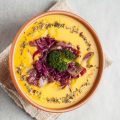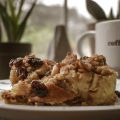Making injera, the tangy Ethiopian flatbread, can seem scary for newbies. The fermentation process and unfamiliar ingredients may hold you back, but I promise it’s not scary. You can definitely learn how to make injera in your own kitchen. Here’s my step-by-step recipe, and I’ll share my secrets to achieving the perfect texture and flavor!

Table of Contents
- What is Injera?
- Ingredients Needed
- Kitchen Tools Required
- Preparing the Batter
- Cooking
- Serving Suggestions
- Common Mistakes
- Alternative Injera Recipe Using All-Purpose Flour
- Ready, Set, Make It Yourself!
- How to Make Injera: FAQs
What is Injera?
Injera is a traditional Ethiopian and Eritrean flatbread made from teff flour, a gluten-free grain native to the Horn of Africa. The fermentation process used in making injera gives the bread its distinctive spongy texture and slightly sour flavor.
In Ethiopian and Eritrean culture, injera serves not only as a delicious accompaniment to various stews and dishes but also as a plate and utensil. You tear off pieces of the injera and use them to scoop up the flavorful toppings.
Ingredients Needed
To make authentic injera, you’ll need just a few simple ingredients:
- 2 cups teff flour
- 4 cups water
- 1/2 teaspoon salt
Teff flour is the star of the show when it comes to injera. You can find teff flour at many health food stores or online retailers. When shopping for teff flour, look for a finely milled variety for the best results. Some recipes may call for a combination of teff and other gluten-free flours like sorghum or rice flour, but for a traditional injera, stick with 100% teff flour.
The water in this recipe is essential for creating the perfect batter consistency and allowing the fermentation process to take place. Be sure to use room temperature water for the best results.
A pinch of salt helps to enhance the flavor of the injera without overpowering the natural taste of the teff flour.
- WHOLE GRAIN GOODNESS: Teff Flour is a pleasingly light, uniquely flavored, 100% whole grain flour; use it to make Ethopian Injera flatbread, pie crust, cookies, bread and more
Prices pulled from the Amazon Product Advertising API on:
Product prices and availability are accurate as of the date/time indicated and are subject to change. Any price and availability information displayed on [relevant Amazon Site(s), as applicable] at the time of purchase will apply to the purchase of this product.
Kitchen Tools Required
Mitad (Injera Cooker)
To make authentic injera, you’ll need a special pan called a mitad. This flat, round, and slightly curved griddle is traditionally made from clay, but modern versions are often crafted from non-stick materials like Teflon or ceramic. The mitad’s unique shape allows the injera batter to spread evenly and cook to perfection.
- Nonstick Crepe Pan: The nonstick crepe pan is coated with a durable Teflon coating that prevents food from sticking and makes cleanup a breeze. The crepe pan is also lightweight and easy to handle, making it perfect for beginners.
Prices pulled from the Amazon Product Advertising API on:
Product prices and availability are accurate as of the date/time indicated and are subject to change. Any price and availability information displayed on [relevant Amazon Site(s), as applicable] at the time of purchase will apply to the purchase of this product.
Mixing Bowl
Choose a bowl that’s spacious enough to accommodate the batter’s expansion during the fermentation process. Glass, ceramic, or food-grade plastic bowls work well for this purpose.
Additional Cooking Utensils
You’ll need a few other kitchen tools to make your injera-making experience smoother:
- A whisk or wooden spoon
- A ladle or measuring cup with a spout (for pouring batter)
- A lidded container (for storing leftover injera)
- A clean kitchen towel or cheesecloth (for covering the batter during fermentation)
Preparing the Batter
Mixing the Ingredients
To create your injera batter, start by combining the teff flour, water, and salt in a large mixing bowl. Use a whisk or wooden spoon to stir the ingredients together until a smooth, lump-free batter forms. The consistency should be similar to that of a thin pancake batter.
Fermenting the Batter
Once your batter is mixed, cover the bowl with a clean kitchen towel or plastic wrap and let it sit at room temperature for 24 to 48 hours. During this time, the batter will begin to ferment, developing the signature sour taste and bubbly texture that makes injera so unique.
The fermentation process is crucial for achieving the desired flavor and texture of injera. As the batter ferments, it will develop a slightly sour aroma and become foamy. This is a good sign that the natural yeasts and bacteria present in the teff flour are working their magic.
Checking the Batter’s Readiness
After 24 hours, check your batter to see if it has reached the desired level of fermentation. The batter should have a pleasantly sour smell and be filled with tiny bubbles. If the batter hasn’t reached this stage yet, let it continue fermenting for another 12 to 24 hours.
Once your batter is properly fermented, give it a gentle stir to redistribute the bubbles and ensure a consistent texture. If the batter seems too thick, add a little water to thin it out. If it’s too thin, add a bit more teff flour to thicken it up.
Cooking
Preheating the Mitad
Set the stove to medium-high heat and allow the mitad to heat up for about 5 minutes. To test if the mitad is ready, sprinkle a few drops of water on the surface. If the water sizzles and evaporates quickly, it’s time to start cooking.
Pouring the Batter
Once your mitad is hot, use a ladle or measuring cup to pour a thin layer of batter onto the center of the pan. Quickly tilt and swirl the mitad to evenly distribute the batter across the surface. The key is to create a thin, even layer that covers the entire mitad.
Cooking the Injera
After pouring the batter, cover the mitad with a lid and let the injera cook for about 30 seconds to 1 minute. During this time, you’ll notice the injera’s surface transforming, with tiny bubbles forming and the edges beginning to curl up and away from the pan.
Unlike pancakes or crepes, you don’t need to flip injera. The steam trapped beneath the lid cooks the top of the injera, while the heat from the mitad cooks the bottom. This unique cooking method is what gives injera its spongy texture and distinctive appearance.
Removing and Storing Injera
Once the injera is cooked, carefully remove it from the mitad using a spatula or your fingers. Place the cooked injera on a clean kitchen towel or a large plate, and cover it with another towel to keep it warm and moist.

Serving Suggestions
Accompaniments
Injera is the perfect companion for a wide array of Ethiopian and Eritrean stews, known as wats or wots. These flavorful dishes, made with ingredients like beef, chicken, lamb, lentils, or vegetables, are typically served family-style on a large platter lined with injera.
How to Eat
When serving injera, it’s customary to fold or roll it into neat triangles or cylinders.
To fold injera, start by cutting or tearing it into rough squares or rectangles. Then, fold each piece in half diagonally to create a triangle, or roll it up tightly to form a cylinder.
Storing Leftovers
Store any leftovers it in an airtight container at room temperature for up to three days. To keep the injera soft and pliable, place a clean kitchen towel or paper towel in the container to absorb any excess moisture.
Simply reheat it in a microwave or steam it briefly to restore its texture.
Common Mistakes
In this section I’m going to attempt to cover some issues you may face, so you don’t get deterred from making this in your own kitchen!
Incorrect Batter Consistency
If the batter is too thick, your injera may turn out dense and heavy. On the other hand, if it’s too thin, the injera may not develop the desired spongy texture and signature holes.
Aim for a batter that resembles the consistency of a thin pancake batter. If needed, adjust the consistency by adding more water or teff flour until you achieve the perfect balance. A good rule of thumb is to start with the recommended proportions in the recipe and make small adjustments as needed.
Improper Cooking Temperature
If the mitad or pan is too hot, the injera may cook too quickly on the outside while remaining undercooked on the inside. Conversely, if the temperature is too low, the injera may take longer to cook and may not develop the desired texture.
Preheat your mitad or non-stick pan over medium-high heat for about 5 minutes. Test the temperature by sprinkling a few drops of water on the surface – if the water sizzles and evaporates quickly, you’re ready to start cooking. Adjust the heat as necessary to maintain a consistent temperature throughout the cooking process.
Not Letting the Batter Ferment Long Enough
Reminder that it’s very important to allow the batter to ferment for the right amount of time. If you don’t let the batter ferment long enough, your injera may lack the characteristic sour taste and spongy texture.
Let your batter ferment at room temperature for 24 to 48 hours, or until it develops a pleasantly sour smell and is filled with tiny bubbles. Check the batter’s readiness before cooking, and if needed, let it ferment for a bit longer to achieve the desired results.
Keep in mind that fermentation times may vary depending on factors like room temperature and humidity, so be patient and trust your senses.

Alternative Injera Recipe Using All-Purpose Flour
If you’re eager to make injera at home but can’t find teff flour, don’t worry! You can still make this using a common pantry staple: all-purpose flour. Using all-purpose flour allows you to explore injera-making without the need for specialty ingredients.
While the taste and texture may differ slightly from traditional injera, this alternative recipe can make this recipe more accessible to make.
Adjustments
You’ll need to make a few adjustments to the traditional recipe. Start by mixing 2 cups of all-purpose flour with 2 cups of water and 1/2 teaspoon of salt. To help the batter ferment and develop that signature sour taste, you can add 1/2 teaspoon of instant yeast or a sourdough starter if you have one.
Let the batter ferment at room temperature for 24 to 48 hours, just like you would with teff flour. The fermentation process is crucial for achieving the desired flavor and bubbly texture.
Cooking and Texture
Heat a non-stick frying pan or skillet over medium-high heat. Pour a thin layer of batter onto the pan, swirling it to cover the surface evenly. Cover the pan with a lid and cook for 30 seconds to 1 minute, until the top is set and the bottom is lightly golden.
Injera made with all-purpose flour may have a slightly different texture than traditional injera. It may be less spongy and more crepe-like, with fewer of the characteristic “eyes” or holes on the surface. However, it will still be delicious and perfect for scooping up your favorite Ethiopian stews and sauces.
Tips for Success
- Make sure your batter is well-fermented before cooking. The longer it ferments, the more complex and tangy the flavor will be.
- Experiment with the batter consistency. If it seems too thick, add a little more water. If it’s too thin, add a bit more flour.
- Don’t flip the injera while cooking. The steam trapped under the lid will cook the top, while the heat from the pan cooks the bottom.
- Serve the injera warm and fresh for the best taste and texture.
Ready, Set, Make It Yourself!
Making authentic injera is achievable with patience and practice. You can definitely successfully make this delightful Ethiopian and Eritrean staple at home, I feel it!
How to Make Injera: FAQs
What are the steps to make injera?
To make injera, mix teff flour, water, and a starter (such as leftover injera). Let the batter ferment for a few days. Heat a lightly oiled pan, pour a thin layer of batter, and cook until holes form on the surface. Do not flip. Remove from the pan and repeat. Injera is best served fresh and warm.
How was injera made?
Traditionally, injera was made by mixing teff flour with water and a starter, such as ersho (a fermented dough). The batter was then left to ferment for several days. Once fermented, the batter was poured onto a hot, lightly oiled clay griddle called a mitad. The injera was cooked until holes formed on the surface and then removed from the griddle.
Is making injera hard?
Making injera can be challenging, as it requires patience and practice. The fermentation process takes several days, and achieving the right consistency and texture of the batter is crucial. Cooking injera on the right temperature and for the appropriate time also takes some trial and error. However, with experience and the right techniques, making injera becomes easier over time.
Is injera good or bad for you?
Injera is generally considered a healthy food. Teff, the main ingredient, is a nutritious grain high in fiber, protein, and minerals like iron and calcium. The fermentation process also enhances the bioavailability of nutrients and may provide probiotic benefits. However, injera is high in carbohydrates, so individuals with specific dietary restrictions or health concerns should consume it in moderation.

Injera (Ethiopian Flatbread)
- Total Time: 0 hours
- Yield: 8–10 injeras 1x
Ingredients
- 2 cups teff flour
- 4 cups water
- 1/2 teaspoon salt
Tools
- Mitad (Injera Cooker) or a non-stick frying pan
- Mixing Bowl
- Whisk or Wooden Spoon
- Ladle or Measuring Cup
- Lidded Container
- Clean Kitchen Towel or Cheesecloth
Instructions
- In a large mixing bowl, combine the teff flour, water, and salt. Stir with a whisk or wooden spoon until the batter is smooth and lump-free, similar to a thin pancake batter.
- Cover the bowl with a clean kitchen towel or plastic wrap. Let it sit at room temperature for 24-48 hours, until it becomes foamy and has a pleasantly sour smell.
- Heat the mitad or pan over medium-high heat for about 5 minutes. Test readiness by sprinkling a few drops of water; if they sizzle and evaporate quickly, it’s ready.
- Pour a thin layer of batter onto the center of the mitad, then quickly tilt and swirl to evenly distribute the batter.
- Cover and cook for about 30-60 seconds, until the surface is bubbly and the edges lift from the pan. Do not flip the injera.
- Carefully remove the injera and place it on a clean towel. Cover it with another towel to keep it warm and moist. Store any leftovers in an airtight container at room temperature for up to three days.
Notes
- Adjust with more water or flour to get a thin pancake-like batter.
- Depending on room temperature and humidity, fermentation might take longer; trust your senses.
- Ensure the mitad or pan is not too hot or too cool by adjusting the heat as needed.
- Serve injera with various stews (wats or wots) using the injera as a plate and utensil. Fold or roll it into triangles or cylinders for neat serving.
- Prep Time: 48-72 hours (including fermentation)
- Cook Time: 1-2 minutes
- Cuisine: Ethiopian







![How To Make Pain De Campagne (French Country Bread) 97 How to make pain de campagne [french country bread]](https://www.mydailysourdoughbread.com/wp-content/uploads/2024/04/how-to-make-Pain-de-campagne-3-120x120.jpg)
